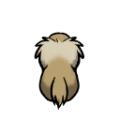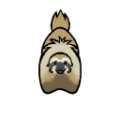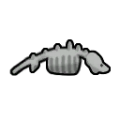Difference between revisions of "Megasloth"
m (You'd think I'd know my own format by now...) |
m (→Wool) |
||
| Line 87: | Line 87: | ||
Megasloths produce [[megasloth wool]], though they are the worst animal for wool quantity. 3 [[alpaca]]s eat less than 1 megasloth, and produce wool at {{icon small|Alpaca wool}} 13.5 [[alpaca wool]] per day. A megasloth produces {{icon small|Megasloth wool}} 10 wool per day. | Megasloths produce [[megasloth wool]], though they are the worst animal for wool quantity. 3 [[alpaca]]s eat less than 1 megasloth, and produce wool at {{icon small|Alpaca wool}} 13.5 [[alpaca wool]] per day. A megasloth produces {{icon small|Megasloth wool}} 10 wool per day. | ||
| − | Megasloths are theoretically the most work efficient animal for wool, however, since megasloths are not [[pen animal]]s, they need to be re-trained constantly. | + | Megasloths are theoretically the most work efficient animal for wool, however, since megasloths are not [[pen animal]]s, they need to be re-trained constantly. Combined with their difficulty to tame, and their wool is usually an afterthought. |
As compensation, megasloth wool insulates well against the cold, being the 2nd best [[textile]] for cold protection. Unlike their [[heavy fur|fur]], megasloth wool is not physically protective, with it being slightly worse than [[plainleather]]. | As compensation, megasloth wool insulates well against the cold, being the 2nd best [[textile]] for cold protection. Unlike their [[heavy fur|fur]], megasloth wool is not physically protective, with it being slightly worse than [[plainleather]]. | ||
Revision as of 18:33, 17 March 2023
Megasloth
A giant, solitary herbivore with two giant claws for warding off threats. Long extinct after being wiped out by the natives of Earth's American continent, the megasloth was later brought back using advanced cloning and artificial gestators. Its thick hide is exceptionally strong and insulating, and makes a great leather for cold-weather clothing. It is peaceful if left alone, but will shred anyone who disturbs it with its giant claws.
Base Stats
- Type
- Animal
- Flammability
- 70%
Pawn Stats
- Move Speed
- 4.8 c/s
- Health Scale
- 3.6
- Body Size
- 4
- Mass - Baby
- 48 kg
- Mass - Juvenile
- 120 kg
- Mass - Adult
- 240 kg
- Carrying Capacity
- 300 kg
- Filth Rate
- 24
- Hunger Rate
- 1.6 Nutrition/Day
- Diet
- herbivorous
- Life Expectancy
- 20 years
- Manhunter Chance
- 50%
- Manhunter Chance (Taming)
- 30%
- Trainable Intelligence
- Advanced
- Wildness
- 97%
- Minimum Handling Skill
- 10
- Mate Interval
- 12 hours
- Maturity Age
- 0.667 years (40 days)
- Juvenile Age
- 0.333 years (20 days)
- Comfortable Temp Range
- -55 °C – 40 °C (-67 °F – 104 °F)
Production
- Meat Yield
- 560 megasloth meat
- Leather Yield
- 160 heavy fur
- Wool Amount
- 200 megasloth wool
- Shearing Interval
- 20 days
- Gestation Period
- 13.32 days
- Offspring Per Birth
- 1
Melee Combat
- Attack 1
- Front left paw
21 dmg (Scratch)
31 % AP
2 second cooldown - Attack 2
- Front right paw
21 dmg (Scratch)
31 % AP
2 second cooldown - Attack 3
- Teeth
22 dmg (Bite)
33 % AP
2.6 second cooldown
0.7 chance factor - Attack 4
- Head
15 dmg (Blunt)
22 % AP
2 second cooldown
0.2 chance factor - Average DPS
- 5.73
- tradeTags
- AnimalUncommon, AnimalFighter
The megasloth is a giant, ancient sloth. Megasloths can be found in temperate forests, temperate swamps, arid shrublands, boreal forests, cold bogs, tundra, and ice sheets
If tamed, it produces Megasloth wool at a rate of 200 every 20 days.
Analysis
Although being a "sloth", it actually has a slightly faster movement speed than a human. Attacking one is quite dangerous and taming one will require both high skill and considerable risk. It is the second hardest animal after the Thrumbo to tame, and with most skill levels, the manhunter chance is higher than the taming chance. Wounding then saving the megasloth, or waiting for an inspiration is the recommended way to tame one.
As an attack animal
If it can be tamed, it makes for a good attack or damage soak animal. Compared to other bulky attack animals, it is joint second in health and second highest in DPS, despite only eating as much as a human colonist.
| Animal | Health Scale | DPS | Move Speed | Hunger rate | Training Decay |
|---|---|---|---|---|---|
| Thrumbo | 8 | 6.33 | 5.5 | 2.8 | 6.1 |
| Megasloth | 3.6 | 5.73 | 4.8 | 1.6 | 6.2 |
| Elephant | 3.6 | 5.35 | 4.8 | 2.57 | 7.5 |
| Rhinoceros | 3.5 | 5.24 | 5 | 1.71 | 6.6 |
| Bear | 2.5 | 4.89 | 4.6 | 0.56 | 7.2 |
As attack and hauling animals, megasloths face heavy competition with elephants. Elephants have less wildness, which means they produce less filth, are easier to train, and need to be trained less often. In addition, elephants are pack animals, and won't go manhunter on a failed taming attempt. However, elephants can only be found in tropical rainforests, tropical swamps, and arid shrublands. They eat more food than megasloths, but as grass is free, this usually isn't a problem.
Note that megasloths are the only combat animal that produces wool. All other wool-producing animals are pen animals and cannot be used in combat.
Wool
Megasloths produce megasloth wool, though they are the worst animal for wool quantity. 3 alpacas eat less than 1 megasloth, and produce wool at ![]() 13.5 alpaca wool per day. A megasloth produces
13.5 alpaca wool per day. A megasloth produces ![]() 10 wool per day.
10 wool per day.
Megasloths are theoretically the most work efficient animal for wool, however, since megasloths are not pen animals, they need to be re-trained constantly. Combined with their difficulty to tame, and their wool is usually an afterthought.
As compensation, megasloth wool insulates well against the cold, being the 2nd best textile for cold protection. Unlike their fur, megasloth wool is not physically protective, with it being slightly worse than plainleather.
Training
This animal can be trained as follows:
| Guard: | |
|---|---|
| Attack: | |
| Rescue: | |
| Haul: | |
*As of version 1.1.2610, all animals can be tamed. The percentage of likelihood of success depends on factors such as the Animals Wildness Percentage, Pawn Handling Skill, and others. More information can be found on the animals page.
Health
Gallery
Version history
- 0.16.1393 - Renamed from Megatherium to Megasloth.



